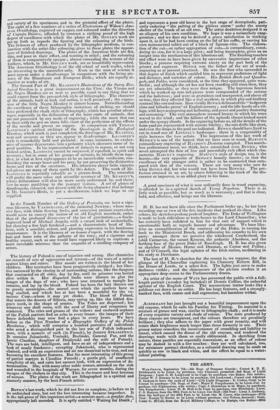Bzwwx'slast work, which he did not live to complete, is
before us in .rts unfinished state, but not the less interesting because imperfect. It is the tail-piece of this ingenious artist—a memento mori---a graphic finis, .appropriately left unended. It is aptly entitled "Waiting for Death ;"
and represents a poor old horse in the last stage of decrepitude, patiently enduring "the pelting of the pitiless storm" under the scanty shelter of the trunk of an old tree. The artist doubtless designed it as an allegory of his own condition. We hope it was a melancholy exaggeration ; and we dare say he derived a grave satisfaction in working upon it, as if he had been cutting on the lid of his coffin, or carving his own monumental tablet out of a block of lignum-vitx. The elaboration of the cut—or rather aggregation of cuts—is extraordinary, considering its size, for it is a large print ; and being incomplete, gives us an insight into the mechanism of this laborious art. The finishing touches and effect were to have been given by successive impressions of other blocks ; a process requiring extreme nicety on the part both of the printer and engraver. BEWICK was the father of the art of woodengraving as at present practised. He was the first who succeeded in that degree of finish which enabled him to represent gradations of light and distance, and varieties of colour. His British Birds and Quadrupeds, and Fables, were considered, at the time they appeared, quite wonderful; and although the art has not been standing still since then, they are yet admirable, as they were then unique. The ingenious fancies which he worked up into tail-pieces were compounded of the serious and the ludicrous ; and were so gratuitous and unexpected, and above all so true, that they affected like a real accident, in which pity and drollery contend like sun and rain. How vividly Bawica. delineated the "hedgerow elms and hillocks green" of English scenery; and the idle bustle of a village, with boys scampering and hallooing, and geese and poultry fluttering and screaming ! The very atmosphere seemed breezy in which his trees waved to the wind ; and the fellows of the uplands almost looked moist under the spongy clouds. In the engraving before us, all the details of the farm-yard are represented with mintite fidelity; the rain drifts like sleet, and even the drops in the pool are indicated. BEwicashould have lived to cut in wood one of LINNELL'S landscapes : there is a congeniality of style between the two artists. The impression of this last work of BEWICK'S is one of the largest that we have seen in wood, HARVEY'S extraordinary engraving of HAYDON'S Dentatus excepted. That matchless performance must, we think, have, astonished even BEWICK ; who never attempted the flow of line and powerfully rich effect which characterize HARVEY'S engraving. HARVEY'S style of design, too, is the heroic—the very opposite of BEWICK'S homely fancies ; so that the excellence of the younger artist is rather to be contrasted than compared with that of the veteran. There are very many who now do what BEWICK did, but who would not have been BEWICKS. The perfection attained in an art, by others following in the track of the discoverer or improver, is an added glory to his fame.


























 Previous page
Previous page